
Synapsida is one of the two major clades of vertebrate animals in the group Amniota, the other being the Sauropsida. The synapsids were the dominant land animals in the late Paleozoic and early Mesozoic, but the only group that survived into the Cenozoic are mammals. Unlike other amniotes, synapsids have a single temporal fenestra, an opening low in the skull roof behind each eye orbit, leaving a bony arch beneath each; this accounts for their name. The distinctive temporal fenestra developed about 318 million years ago during the Late Carboniferous period, when synapsids and sauropsids diverged, but was subsequently merged with the orbit in early mammals.

Therapsida is a clade composing of a major group of eupelycosaurian synapsids that includes mammals and their ancestors and close relatives. Many of the traits today seen as unique to mammals had their origin within early therapsids, including limbs that were oriented more underneath the body, resulting in a more "standing" quadripedal posture, as opposed to the lower sprawling posture of many reptiles and amphibians.
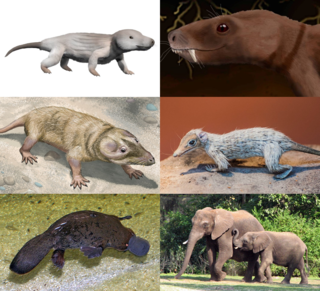
Cynodontia is a clade of eutheriodont therapsids that first appeared in the Late Permian, and extensively diversified after the Permian–Triassic extinction event. Mammals are cynodonts, as are their extinct ancestors and close relatives (Mammaliaformes), having evolved from advanced probainognathian cynodonts during the Late Triassic.

Eucynodontia is a clade of cynodont therapsids including mammals and most non-mammalian cynodonts. The oldest eucynodonts are known from the Early Triassic and possibly Late Permian. Eucynodontia includes two major subgroups, Cynognathia and Probainognathia.

Megazostrodon is an extinct genus of basal mammaliaforms belonging to the order Morganucodonta. It is approximately 200 million years old. Two species are known: M. rudnerae from the Early Jurassic of Lesotho and South Africa, and M. chenali from the Late Triassic of France.
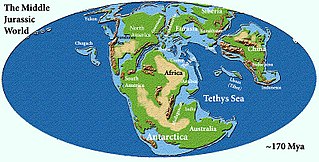
The Middle Jurassic is the second epoch of the Jurassic Period. It lasted from about 174.1 to 161.5 million years ago. Fossils of land-dwelling animals, such as dinosaurs, from the Middle Jurassic are relatively rare, but geological formations containing land animal fossils include the Forest Marble Formation in England, the Kilmaluag Formation in Scotland, the Calcaire de Caen of France, the Daohugou Beds in China, the Itat Formation in Russia, the Tiouraren Formation of Niger, and the Isalo III Formation of western Madagascar.
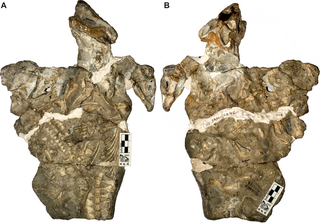
Galesaurus is an extinct genus of carnivorous cynodont therapsid that lived between the Induan and the Olenekian stages of the Early Triassic in what is now South Africa. It was incorrectly classified as a dinosaur by Sir Richard Owen in 1859.

Therocephalia is an extinct clade of eutheriodont therapsids from the Permian and Triassic periods. The therocephalians ("beast-heads") are named after their large skulls, which, along with the structure of their teeth, suggest that they were carnivores. Like other non-mammalian synapsids, therocephalians were once described as "mammal-like reptiles". Therocephalia is the group most closely related to the cynodonts, which gave rise to the mammals, and this relationship takes evidence in a variety of skeletal features. Indeed, it had been proposed that cynodonts may have evolved from therocephalians and so that therocephalians as recognised are paraphyletic in relation to cynodonts.

The theriodonts are a major group of therapsids which appeared during the Middle Permian and which includes the gorgonopsians and the eutheriodonts, itself including the therocephalians and the cynodonts.
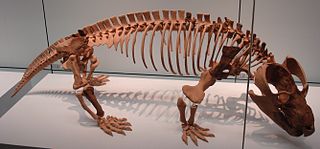
Probainognathia is one of the two major subgroups of the clade Eucynodontia, the other being Cynognathia. The earliest forms were carnivorous and insectivorous, though some groups eventually also evolved herbivorous diets. The earliest and most basal probainognathian is the Middle Triassic (Anisian) aged Lumkuia, from South Africa, though probainognathians would not become prominent until the mid Norian stage of the Late Triassic. Three groups survived the extinction at the end of Triassic: Tritheledontidae and Tritylodontidae, which both survived until the Jurassic—the latter even into the Cretaceous —and Mammaliaformes, which includes the mammals.

Galesauridae is an extinct family of cynodonts. Along with the family Thrinaxodontidae and the extensive clade Eucynodontia, it makes up the unranked taxon called Epicynodontia. Galesaurids first appeared in the very latest Permian period, just a million years before the greatest extinction of all time, the Permian-Triassic extinction event.
Tritylodontidae is an extinct family of small to medium-sized, highly specialized mammal-like cynodonts, with several mammalian traits including erect limbs, endothermy and details of the skeleton. They were the last-known family of the non-mammaliaform synapsids, persisting into the Early Cretaceous.

Tritheledontidae, the tritheledontids or ictidosaurs, is an extinct family of small to medium-sized cynodonts. They were highly mammal-like, specialized cynodonts, although they still retained a few reptile-like anatomical traits. Tritheledontids were mainly carnivorous or insectivorous, though some species may have developed omnivory. Their skeletons show that they had a close relationship to mammals. Tritheledontids or their closest relatives may have given rise to the mammaliaforms. The tritheledontids were one of the longest lived non-mammalian therapsid lineages, living from the late Triassic to the Jurassic period. Tritheledontids became extinct in the Jurassic period, possibly due to competition with prehistoric mammals such as the eutriconodonts. They are known from finds in South America and South Africa, indicating that they may have lived only on the supercontinent of Gondwana. The family Tritheledontidae was named by South African paleontologist Robert Broom in 1912. The family is often misspelled "Trithelodontidae".
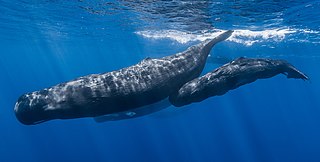
Epicynodontia is a clade of cynodont therapsids that includes most cynodonts, such as galesaurids, thrinaxodontids, and Eucynodontia. It was erected as a stem-based taxon by Hopson and Kitching (2001) and defined as the most inclusive clade containing Mammalia and excluding Procynosuchus, a Late Permian genus that is one of the most basal cynodonts.

Theriognathus is an extinct genus of therocephalian therapsid belonging to the family Whaitsiidae, known from fossils from South Africa, Zambia, and Tanzania. Theriognathus has been dated as existing during the Late Permian. Although Theriognathus means mammal jaw, the lower jaw is actually made up of several bones as seen in modern reptiles, in contrast to mammals. Theriognathus displayed many different reptilian and mammalian characteristics. For example, Theriognathus had canine teeth like mammals, and a secondary palate, multiple bones in the mandible, and a typical reptilian jaw joint, all characteristics of reptiles. It is speculated that Theriognathus was either carnivorous or omnivorous based on its teeth, and was suited to hunting small prey in undergrowth. This synapsid adopted a sleek profile of a mammalian predator, with a narrow snout and around 1 meter long. Theriognathus is represented by 56 specimens in the fossil record.

Progalesaurus is an extinct genus of galesaurid cynodont from the early Triassic. Progalesaurus is known from a single fossil of the species Progalesaurus lootsbergensis, found in the Lystrosaurus Assemblage Zone of the Balfour Formation. Close relatives of Progalesaurus, other galesaurids, include Galesaurus and Cynosaurus. Galesaurids appeared just before the Permian-Triassic extinction event, and disappeared from the fossil record in the Middle-Triassic.

Trirachodon is an extinct genus of cynodonts. Fossils have been found in the Cynognathus Assemblage Zone of the Beaufort Group in South Africa and the Omingonde Formation of Namibia, dating back to the Early and Middle Triassic.

Diademodon is an extinct genus of cynodonts. It was about 2 metres (6.6 ft) long.
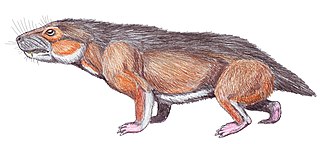
Eutheriodontia is a clade of therapsids which appear during the Middle Permian and which includes therocephalians and cynodonts, this latter group including mammals and related forms.
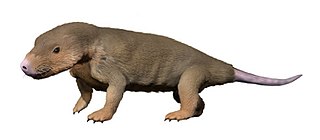
Abdalodon is an extinct genus of late Permian cynodonts, known by its only species A. diastematicus.Abdalodon together with the genus Charassognathus, form the clade Charassognathidae. This clade represents the earliest known cynodonts, and is the first known radiation of Permian cynodonts.
























